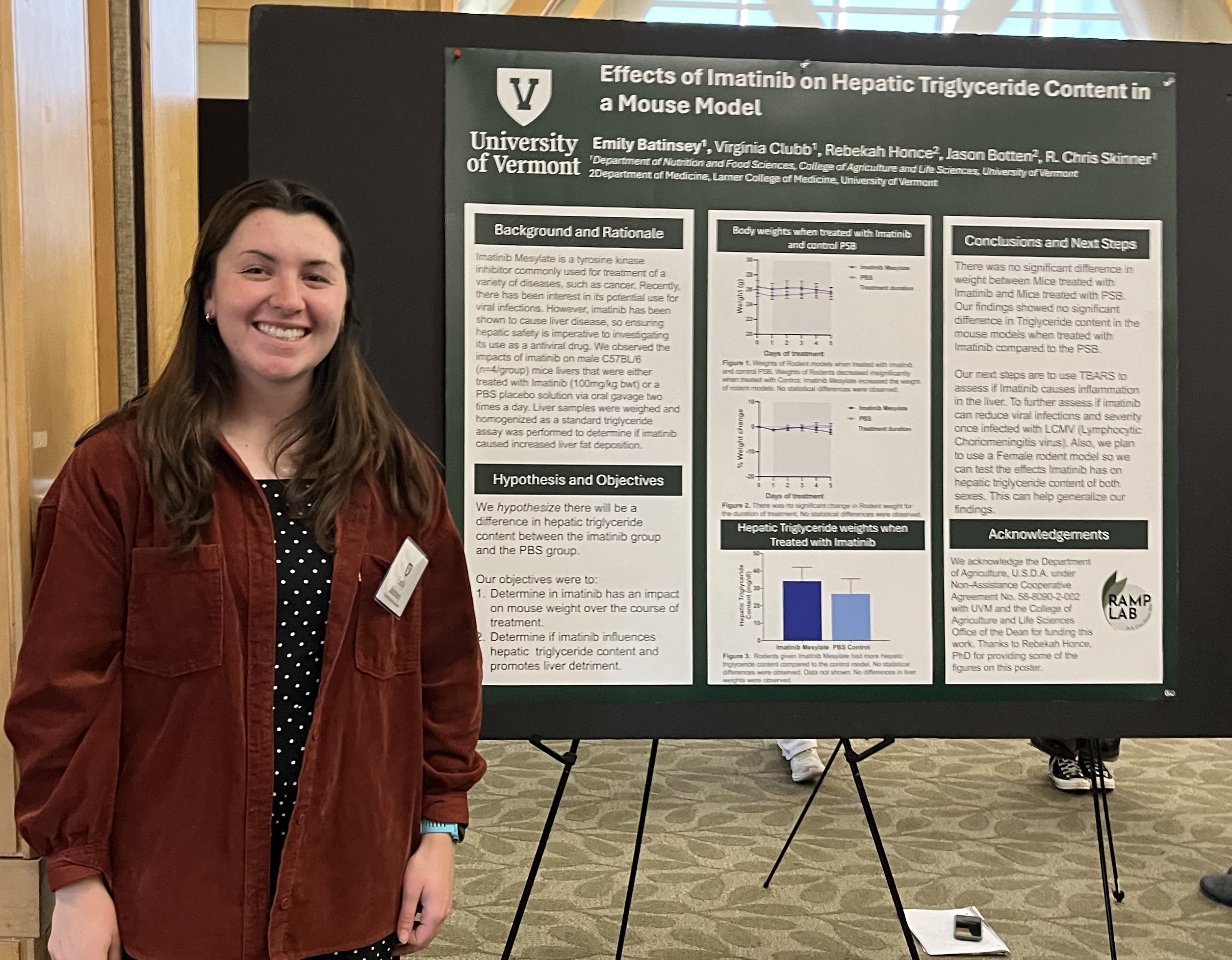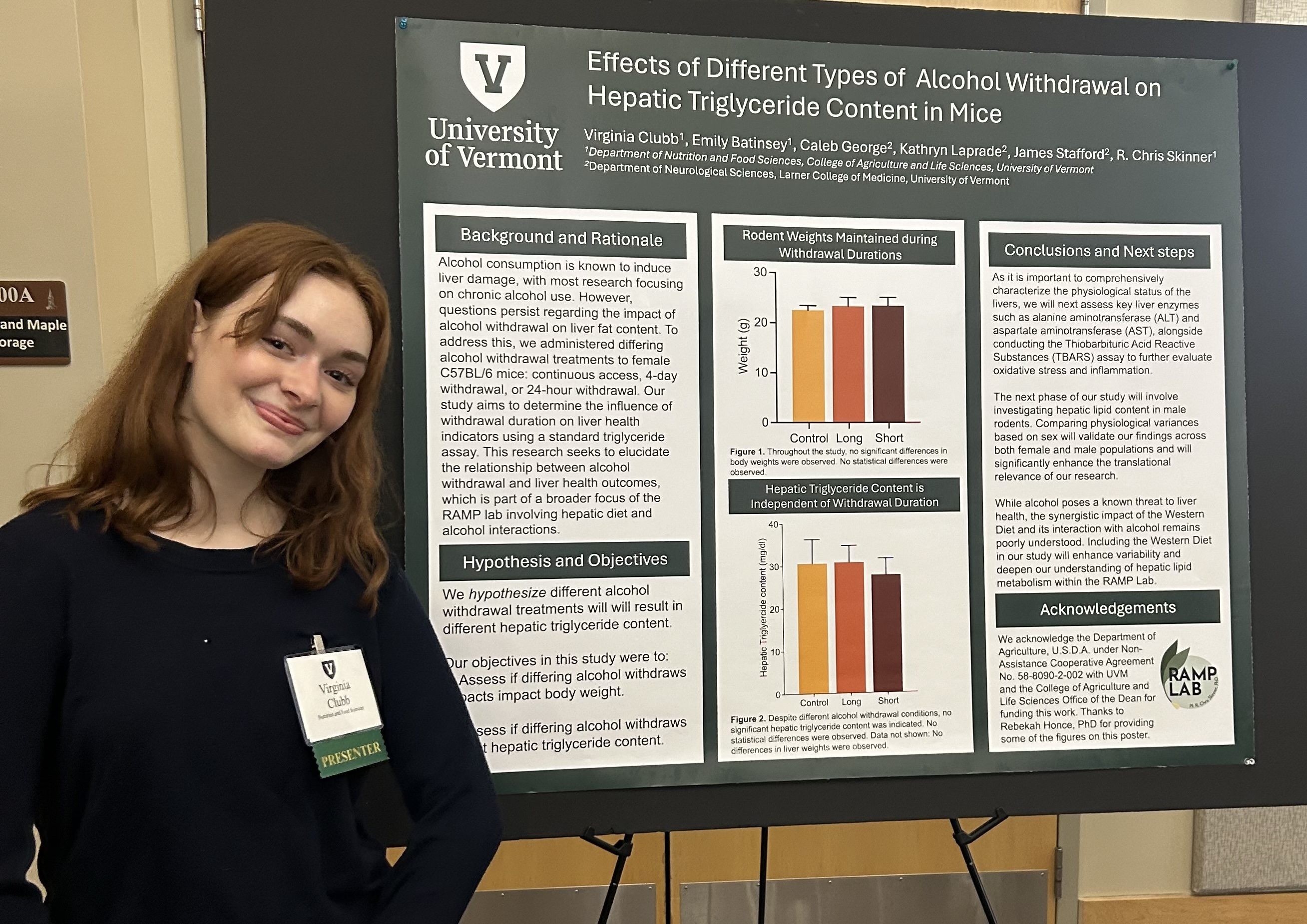People
R. Chris Skinner, PhD, PI
 Chris is an Assistant Professor in the Department of Nutrition and Food Sciences. He is largely interested in the impacts of lifestyle factors on liver health. Chris started as a PI at UVM in 2023 after working with the UVM Food Systems Research Center for a couple years. Prior to moving to Vermont, Chris worked as an Assistant Professor at University of the Ozarks, a small liberal arts college in Clarksville, AR. He maintains collaborations with faculty at Ozarks and is very interested in teaching and communicating science. Chris has his PhD in Nutrition and his MS in Exercise Physiology from West Virginia University and his BS in Exercise Science from West Virginia Wesleyan College. Outside of work he enjoys being active, going to concerts, and trying new restaurants.
Chris is an Assistant Professor in the Department of Nutrition and Food Sciences. He is largely interested in the impacts of lifestyle factors on liver health. Chris started as a PI at UVM in 2023 after working with the UVM Food Systems Research Center for a couple years. Prior to moving to Vermont, Chris worked as an Assistant Professor at University of the Ozarks, a small liberal arts college in Clarksville, AR. He maintains collaborations with faculty at Ozarks and is very interested in teaching and communicating science. Chris has his PhD in Nutrition and his MS in Exercise Physiology from West Virginia University and his BS in Exercise Science from West Virginia Wesleyan College. Outside of work he enjoys being active, going to concerts, and trying new restaurants.
Graduate students
We're excited to have a couple graduate students joining the lab in the fall of 2024!
Undergraduate students
Emily Batinsey
 Emily is a Senior at UVM and she is originally from the New York City area. She is working on gaining lab skills and understanding the mechanisms behind the metabolic processes that drive liver disease. Emily has been in the lab since Spring of 2024. Emily's spring project involved analyzing the triglyercide content of livers from mice being given Imatinib, a drug commonly used in cancer treatment that is being explored as an anti-viral. Imatinib has been shown to cause liver damage and Emily was assisting in checking the safety of the drug. She plans to continue her education in food sciences post-graduation. Her food science interests are in food safety and regulation as well as food chemistry. Outside of work, she enjoys baking banana bread and running around Burlington with her friend
Emily is a Senior at UVM and she is originally from the New York City area. She is working on gaining lab skills and understanding the mechanisms behind the metabolic processes that drive liver disease. Emily has been in the lab since Spring of 2024. Emily's spring project involved analyzing the triglyercide content of livers from mice being given Imatinib, a drug commonly used in cancer treatment that is being explored as an anti-viral. Imatinib has been shown to cause liver damage and Emily was assisting in checking the safety of the drug. She plans to continue her education in food sciences post-graduation. Her food science interests are in food safety and regulation as well as food chemistry. Outside of work, she enjoys baking banana bread and running around Burlington with her friend
Virginia "Nina" Clubb
 Nina is a senior at UVM, originally from Los Angeles, who joined the lab in the spring of 2024. Nina's spring project was looking at how different types of alcohol withdrawal impacted liver triglyercide content. Nina analyzed the liver triglyceride content of mice constantly consuming alcohol, on a short alcohol withdrawal, or on a long withdrawal. Nina is expanding this research and working on understanding the mechanisms that drive liver disease caused by diet and alcohol. She plans to be a Registered Dietitian. Outside of work she enjoys reading and hiking.
Nina is a senior at UVM, originally from Los Angeles, who joined the lab in the spring of 2024. Nina's spring project was looking at how different types of alcohol withdrawal impacted liver triglyercide content. Nina analyzed the liver triglyceride content of mice constantly consuming alcohol, on a short alcohol withdrawal, or on a long withdrawal. Nina is expanding this research and working on understanding the mechanisms that drive liver disease caused by diet and alcohol. She plans to be a Registered Dietitian. Outside of work she enjoys reading and hiking.
Lab Alumni
Nora Bodner, BS Food Systems, 2024
Looking to join?
We currently do not have any open postdoc or grad student positions, but I am always open to chatting as funding opportunities may arise. If you are a current UVM undergrad or potential graduate student, please reach out. I am happy to chat about potential opportunities.
